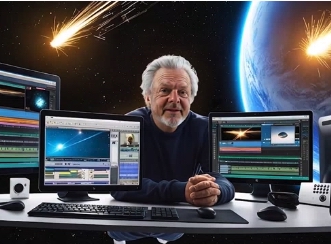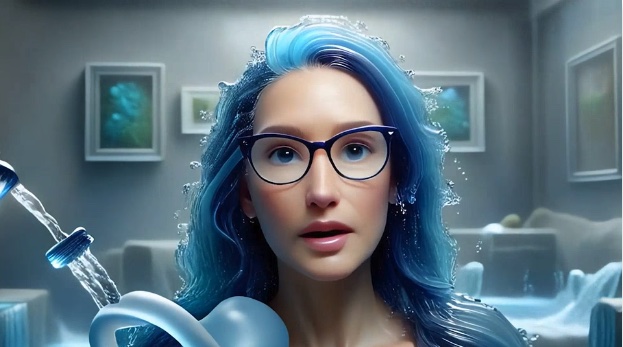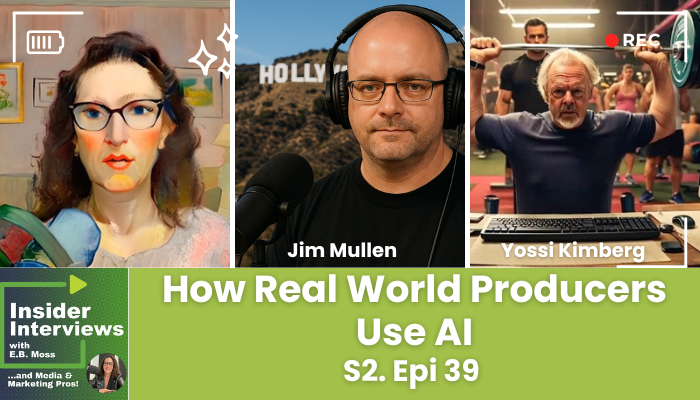Podcast: Play in new window | Download (Duration: 32:20 — 30.1MB) | Embed
Subscribe or Follow Spotify | Android | Pandora | iHeartRadio | TuneIn | Deezer | RSS | More
The first time I heard voices I thought I was losing my mind. AI-generated voices, that is. Because I couldn’t believe how “real” they sounded. Listen to the intro to this episode and tell me what YOU think. Then find the little samples of producer Jim Mullen’s voice later in this episode!
I’m still wrapping my head around all that is possible — and all that has changed in the world of content creation and media production. That’s exactly why I knew I had to bring together two of the most credentialed producers I know to talk about what’s really happening behind the scenes with AI in our industry.
The Real vs. The AI – A Producer’s Perspective
Jim Mullen (Mullen Media) and Yossi Kimberg are the real deal – we’re talking Seinfeld, Food Network, Super Bowl halftime shows, and decades of work on Lorne Michaels shows. These guys aren’t just talking theory; they’re actually using these tools in production right now.


What Really Struck Me
Yossi’s journey into AI started by making masterful still images with Leonardo, as in Leonardo.AI. As he put it:
“The idea that text generates an image was beyond imagination. I was just amazed by it.”
But then he progressed to motion, face-swapping himself into different editing scenarios (find those in this episode, too!), and even bringing children’s artwork to life. But learn what happened next that was “a bridge too far” for one particular client.
Now, while Yossi’s moved on to scripted motion videos all AI-generated, Jim’s been experimenting with ElevenLabs for voiceovers, though he hit a hilarious snag on a project about a lack of libraries:
“I couldn’t get the bot to say ‘desert’. It kept saying, New York City has book desserts.”
Not so funny to me, because once it learns contextual pronunciations, my gigs doing voiceover will dry up like a desert. (Note: I found out just today while producing this episode that I literally lost a job to an AI-generated voice. True story.)
The Uncomfortable Truth
Both producers agree we’re not just approaching a tipping point – we’re already there. Yossi believes that within 2-3 years, even the very role of managing AI might become obsolete. The technology is learning to be funny, dramatic, and emotional without human instruction.
Jim pointed out something that made my stomach drop: if you can create an entire commercial with AI actors and voices (which is already happening), you eliminate hair and makeup artists, grips, gaffers, location scouts – entire production crews become unnecessary. 
As such, we talked about the fear factor. You know how I feel about voiceovers. Though AI helped me immensely in honing these show notes. But it’s not just job displacement we’re facing; it’s questioning our creative thumbprint and what makes us uniquely human in this process. Plus…
Copyright and Ownership Minefield
We touched on some fascinating legal territory that’s still being sorted out. Yossi mentioned reading legal briefs about using copyrighted images in AI training, and the emerging trend of celebrity estates licensing deceased stars’ likenesses for AI projects – Steve McQueen’s estate is apparently leasing his character for AI-generated content. The whole landscape of intellectual property, name-image-likeness rights, and even the ability to deny you said something (“I didn’t say that, it was AI”) creates a complicated web that we’re all navigating in real time.
(I recommend taking a listen to the brilliant Robert Tercek who allays some of those legal fears in this Insider Interviews episode from last year: https://bit.ly/Insider21-Shapiro-Tercek .)
The Human Pushback
But here’s what gives me hope: Yossi shared how his client loved his AI-enhanced children’s artwork until clients pushed back, saying it wasn’t authentic to what the kids actually created. They pulled back some of the AI elements. It reminded us of the vinyl comeback – sometimes we crave imperfection and authenticity. He thinks we’ll find our middle ground once this trend becomes trite.
Practical Advice
For anyone starting out, Jim recommends experimenting with the free trials but warns against buying credits with “one-trick ponies” – platforms that only do one gimmicky thing. Yossi suggests testing the same prompt across different platforms since each has unique strengths.
The tools they’re using: ElevenLabs (voice), Runway, Kling, Higgsfield, Leonardo.ai (images), and the premium Veo3 — for dialogue-driven video at $250/month. I was simply wow’d by the basics of NotebookLM that I used in my intro. But I hope you’ll still call ME for doing the real deal as a human.
The Big Question
As we face this rapid evolution, seems many will become “AI wranglers” rather than traditional producers. The question isn’t whether this technology will change everything – it’s how we adapt while maintaining the humanity that makes content actually connect with people.
I have a feeling we’ll need to revisit this conversation in six months because everything will be dramatically different again.

Key Moments & Time Codes:
[01:36] – AI voices fool me twice – shame on me — on client websites
[05:13] – Yossi’s journey from Leonardo still images to motion graphics
[08:34] – Scholastic project: bringing children’s artwork to life
[11:12] – Jim’s Eleven Labs experiments and the “desserts” problem
[13:58] – Discussion of celebrity estate licensing for AI (Steve McQueen example)
[18:57] – Who gets replaced first: voice actors, then editors
[25:01] – Too much of a good thing: Client pushback on AI-enhanced artwork
[28:17] – Tool recommendations and experimentation advice
Follow, Connect & Share the Love
Connect with E.B. Moss and Insider Interviews: With Media & Marketing Experts
LinkedIn: https://www.linkedin.com/in/mossappeal
Instagram: https://www.instagram.com/insiderinterviews
Facebook: https://www.facebook.com/InsiderInterviewsPodcast/
Threads: https://www.threads.net/@insiderinterviews
If you enjoyed this episode, follow Insider Interviews, share with another smart business leader, and leave a comment on @Apple or @Spotify… or a tip in my jar to help me tip my producer, Jim Mullen!: https://buymeacoffee.com/mossappeal!



